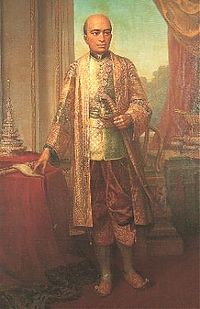Ceramics held many purposes, many of them for holding water and food preparation. However, different ethnic groups had their own styles of formation, materials they used, and ornamentation/design. And these things also changed through time, too. Many of these used a variety of red and black clays, and some may or may not have used glaze. In the early days, these ceramics were often traded with their neighbors. In more recent centuries, ceramics were painted with bright colors and gold on top of the glazed enamel.
Traditional painting in Thai art is for the most part influenced by Buddhism. It also tends to be two-dimensional. But it wasn’t all solely Buddhist-related materials: there were plenty of paintings depicting life at the time and folklore stories as well.
Thailand has some unique architecture for both common homes and for their temples (called wats). Traditional houses were built on stilts to allow for flooding during the rainy seasons and used as storage at other times. Wat architecture has changed throughout the centuries but all have an enclosing wall, which is designed to close it off from the secular world (isn’t that the point of all walls?). Regardless of its era, wats are typically highly decorated with carved designs and can be elaborately painted (often with gold).
Early literature in Thailand is almost exclusively written in Thai and mostly in the form of poetry. Although it was a highly developed artform, many works were lost when the Ayuttahaya fell in 1767. The epic poem of Thao Hung Thao Cheuang (although Laos takes claim for it) was one whose style was unique among other forms of poetry in Thai and Lao literature and would go on to influence the greater literary styles of Southeast Asia. Most prose at this point was basically just historical accounts, court records and the like.
 |
| Scene from Ramakien |
During the 1400s and 1500s as Buddhism and Hinduism spread into Thailand, the Thai language borrowed influences from Indian languages such as Sanskrit and Pali. Poetic styles were also expanding to include different styles like using humor to portray different moods. Thailand did have one epic story called Ramakien, which was basically their rewritten version of the Hindu story Ramayana. (Apparently, there weren’t many plagiarism laws back then, huh.) It played a huge part in creating the dramatic arts that are known today.
 |
| King Rama II |
 |
| Duanwad Pimwana |
Up next: music and dance




No comments:
Post a Comment